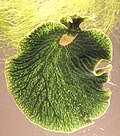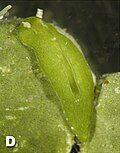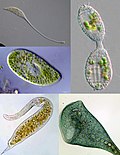Kleptoplasty or kleptoplastidy is a process in symbiotic relationships whereby plastids, notably chloroplasts from algae, are sequestered by the host....
16 KB (1,585 words) - 03:57, 18 May 2024
Costasiellidae. Despite being animals they indirectly perform photosynthesis, via kleptoplasty. Discovered in 1993 off the coast of the Japanese island Kuroshima, Costasiella...
5 KB (392 words) - 05:05, 30 April 2024
The capture and sequestering of photosynthetic cells and chloroplasts, kleptoplasty, occurs in many types of modern eukaryotic organisms. The cytoskeleton...
61 KB (6,038 words) - 09:04, 20 May 2024
Rapaza (section Chloroplasts and kleptoplasty)
retains the chloroplasts of its prey for its own use, a process known as kleptoplasty ('stealing of plastids'). After phagocytosis of the algal prey, its cell...
16 KB (2,305 words) - 02:26, 20 May 2024
chloroplasts from the algae they eat, a very unusual phenomenon known as kleptoplasty, for the "stolen" plastids. This earns them the title of the "solar-powered...
24 KB (2,685 words) - 15:56, 7 May 2024
developed the capacity to sequester ingested plastids—a process known as kleptoplasty. A. F. W. Schimper was the first to name, describe, and provide a clear...
29 KB (3,233 words) - 21:21, 22 May 2024
Elysia atroviridis (section Kleptoplasty)
capable of kleptoplasty, which is the process of taking chloroplasts from digested algae and using them for photosynthesis. Kleptoplasty is performed...
7 KB (673 words) - 16:08, 10 April 2024
Costasiella ocellifera (section Kleptoplasty/feeding)
ocellifera.Costasiella ocellifera shows long-term retention of functional kleptoplasty. The name 'ocellifera' comes from the Latin word for eye, ''ocellus''...
18 KB (2,041 words) - 00:49, 13 April 2024
Elysia crispata (section Kleptoplasty)
quickly, with little chloroplast retention. Upon reaching maturity, kleptoplasty becomes an important energy source. The primary food source of E. crispata...
10 KB (1,149 words) - 18:32, 6 January 2024
S2CID 91740559. Stephenson, India (2017). Species discovery, evolution and kleptoplasty in marine meiofaunal flatworms (MSc). University of British Columbia...
2 KB (121 words) - 19:35, 28 January 2023
chloroplasts from the algae they eat for photosynthesis, a phenomenon known as kleptoplasty. Elysia chlorotica is one species of such "solar-powered sea slugs"....
19 KB (2,187 words) - 23:32, 5 March 2024
chloroplasts, and those with endosymbionts—and those that acquire them through kleptoplasty or through symbiotic associations with prey or enslavement of their organelles...
18 KB (1,679 words) - 13:14, 5 January 2024
Chloroplast (section Kleptoplasty)
A chloroplast (/ˈklɔːrəˌplæst, -plɑːst/) is a type of membrane-bound organelle known as a plastid that conducts photosynthesis mostly in plant and algal...
193 KB (18,774 words) - 07:28, 10 May 2024
(kléptein), κλέπτης (kléptēs) kleptocracy, kleptomania, kleptophobia, kleptoplasty ktet- possession, ownership Greek κτητικός (ktētikós), κτήτωρ (ktḗtōr)...
1 KB (1,336 words) - 06:14, 16 April 2024
Elysia pusilla (section Kleptoplasty)
before hatching. Sacoglossa are the only metazoans on earth to exhibit kleptoplasty. The only other organisms known to have this ability are single celled...
16 KB (1,903 words) - 22:57, 15 January 2024
lettuce-like ruffles that line its body. This slug, like other Sacoglossa, uses kleptoplasty, a process in which the slug absorbs chloroplasts from the algae it eats...
10 KB (1,214 words) - 10:11, 6 May 2024
microalgae has evolved. Some species in the same order has also evolved kleptoplasty. The earliest known fossils confidently classified as tapeworms have...
63 KB (6,546 words) - 15:06, 18 May 2024
capture from the algae in their diet and then store in their bodies (see Kleptoplasty). This allows the mollusks to survive solely by photosynthesis for several...
109 KB (11,570 words) - 18:07, 16 May 2024
the oxygen produced by algal photosynthesis. Some protozoans practice kleptoplasty, stealing chloroplasts from prey organisms and maintaining them within...
52 KB (5,202 words) - 14:22, 5 May 2024
bioluminescent ostracods, including Cypridina noctiluca or Vargula hilgendorfii. Kleptoplasty Bessho-Uehara, Manabu; Yamamoto, Naoyuki; Shigenobu, Shuji; Mori, Hitoshi;...
2 KB (152 words) - 17:10, 6 May 2024
chloroplasts, and those with endosymbionts—and others that acquire them through kleptoplasty or by enslaving the entire phototrophic cell. The distinction between...
77 KB (7,051 words) - 03:48, 21 May 2024
may use alien chloroplasts (cleptochloroplasts), obtained from food (kleptoplasty). Some dinoflagellates may feed on other organisms as predators or parasites...
95 KB (10,292 words) - 09:36, 18 May 2024
the only eukaryotes outside Diaphoretickes to do so without performing kleptoplasty,[failed verification] and so obtain energy through photosynthesis. These...
26 KB (1,734 words) - 12:47, 13 April 2024
some other Sacoglossan species carry out a process called functional kleptoplasty. This is a process in which the digestion of algal plastids consumed...
7 KB (686 words) - 14:13, 7 April 2024
(kléptein), κλέπτης (kléptēs) kleptocracy, kleptomania, kleptophobia, kleptoplasty ktet- possession, ownership Greek κτητικός (ktētikós), κτήτωρ (ktḗtōr)...
3 KB (36 words) - 23:44, 12 March 2024
the chloroplasts for their own photosynthetic use, a process known as kleptoplasty. Some of these species have been observed practicing autotomy, severing...
41 KB (4,219 words) - 22:49, 22 May 2024
except for the plastids, which continues to perform photosynthesis (kleptoplasty). Recognition of the importance of mixotrophy as an ecological strategy...
62 KB (6,455 words) - 22:52, 18 May 2024
kiloliters of bio jet fuel and biodiesel per year. Elysia chlorotica Kleptoplasty "The Euglenoid Project: Alphabetic Listing of Taxa". The Euglenoid Project...
28 KB (3,045 words) - 16:47, 28 April 2024
are also mixotrophic, combining phagotrophy and phototrophy through kleptoplasty or symbiosis with photosynthetic microbes. The ciliate Halteria has been...
33 KB (3,453 words) - 17:25, 27 April 2024
nudibranch aeolids, are known to undergo kleptocnidy (in addition to kleptoplasty), whereby the organisms store nematocysts of digested prey at the tips...
24 KB (2,863 words) - 14:38, 1 May 2024


























